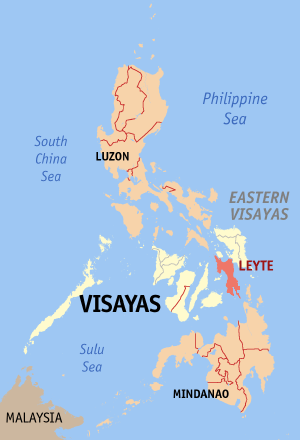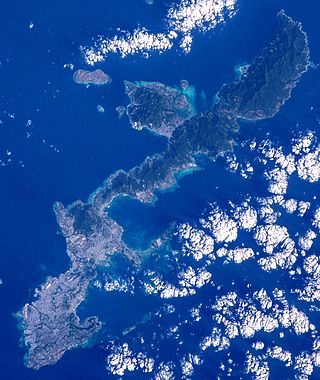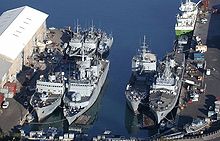
The Boston Navy Yard, originally called the Charlestown Navy Yard and later Boston Naval Shipyard, was one of the oldest shipbuilding facilities in the United States Navy. It was established in 1801 as part of the recent establishment of the new U.S. Department of the Navy in 1798. After 175 years of military service, it was decommissioned as a naval installation on 1 July 1974.

Cam Ranh Bay is a deep-water bay in Vietnam in Khánh Hòa Province. It is located at an inlet of the South China Sea situated on the southeastern coast of Vietnam, between Phan Rang and Nha Trang, approximately 290 kilometers northeast of Ho Chi Minh City.

The Pearl Harbor Naval Shipyard and Intermediate Maintenance Facility is a United States Navy shipyard located in Pearl Harbor, Hawaii on 148 acres. It is one of just four public shipyards operated by the United States Navy. The shipyard is physically a part of Joint Base Pearl Harbor–Hickam.

Naval Base San Diego, also known as 32nd Street Naval Station, is the second largest surface ship base of the United States Navy and is located in San Diego, California. Naval Base San Diego is the principal homeport of the Pacific Fleet, consisting of over 50 ships and over 150 tenant commands. The base is composed of 13 piers stretched over 1,600 acres (650 ha) of land and 326 acres (132 ha) of water. The total on base population is over 24,000 military personnel and over 10,000 civilians.

Royal Navy Dockyards were state-owned harbour facilities where ships of the Royal Navy were built, based, repaired and refitted. Until the mid-19th century the Royal Dockyards were the largest industrial complexes in Britain.
INS Kadamba or Naval Base Karwar or Project Seabird is an Indian Navy base located near Karwar in Karnataka. The first phase of construction of the base, code-named Project Seabird, was completed in 2005 and the base was commissioned on 31 May 2005. Development of Phase II commenced in 2011. INS Kadamba is currently the third largest Indian naval base, and is expected to become the largest naval base in the eastern hemisphere after completion of expansion Phase IIB. The construction of Naval Base covers an area of 11,169 acres in Phase I. The Navy's aircraft carrier INS Vikramaditya is based at Karwar. The base also has the country's first sealift facility, a unique “shiplift” and transfer system for docking and undocking ships and submarines.
The Naval Facilities Engineering Systems Command (NAVFAC) is the United States Navy's engineering systems command, providing the Navy and United States Marine Corps with facilities and expeditionary expertise. NAVFAC is headquartered at the Washington Navy Yard and is under the command of the Chief of Civil Engineers RADM Dean VanderLey

The Ethiopian Navy, known as the Imperial Ethiopian Navy until 1974, is a branch of the Ethiopian National Defense Force founded in 1955. It was disestablished in 1996 after the independence of Eritrea in 1991 left Ethiopia landlocked. In 2019 the Ethiopian Navy was re-established based in Bahir Dar, Amhara region, near Lake Tana.

A Service Squadron (ServRon) was a United States Navy squadron that supported fleet combat ships and US Navy Auxiliary ships. Service Squadrons were used by the US Navy from their inception in 1943 to as late as the early 1980s. At the time of their inception during the Second World War they allowed the US Navy to operate across the vast reaches of the Pacific Ocean for extended periods of time. Service Squadrons created temporary forward bases to allow the naval squadrons to spend less time in transit and more time in the area of combat. Ulithi, a small volcanic atoll in the central Pacific, is an example of a site converted for use as a forward base of supply. Service Squadrons essentially created a major naval base near the area of operation. With naval bases like, Naval Base Ulithi, to refit, repair and resupply, many ships were able to deploy and operate in the western Pacific for a year or more without returning to a major port facility. Among the vessels operating in service squadrons were tankers, Fleet oilers, refrigerator ships, ammunition ships, supply ships, floating docks and repair ships. They provided diesel, ordnance, aviation fuel, food stuffs and all other supplies. Equally important at places like Ulithi were the portable piers and floating dry docks which allowed many ships damaged by enemy action or Pacific storms to undergo repair without having to travel the thousands of miles back to a major US naval base. Ulithi was as far forward from the US naval base at San Francisco as the San Francisco base was from London, England. To have a fully functional major port in the middle of the Pacific was a significant aid to U.S. Navy operations.

A barracks ship or barracks barge or berthing barge, or in civilian use accommodation vessel or accommodation ship, is a ship or a non-self-propelled barge containing a superstructure of a type suitable for use as a temporary barracks for sailors or other military personnel. A barracks ship, a military form of a dormitory ship, may also be used as a receiving unit for sailors who need temporary residence prior to being assigned to their ship. The United States Navy used to call them Yard Repair Berthing and Messing with designations YRBM and YRBM(L) and now classes them as either Auxiliary Personnel Barracks (APB) or Auxiliary Personnel Lighter (aka barge) (APL).

The United States Navy (USN) is the maritime service branch of the United States Armed Forces and one of the eight uniformed services of the United States. It is the largest and most powerful navy in the world, with the estimated tonnage of its active battle fleet alone exceeding the next 13 navies combined, including 11 allies or partner nations of the U.S. as of 2009. It has the highest combined battle fleet tonnage and the world's largest aircraft carrier fleet, with 11 in service, two new carriers under construction, and five other carriers planned. With 336,978 personnel on active duty and 101,583 in the Ready Reserve, the U.S. Navy is the third largest of the United States military service branches in terms of personnel. It has 299 deployable combat vessels and about 4,012 operational aircraft as of July 18, 2023.

Naval Base Subic Bay was a major ship-repair, supply, and rest and recreation facility of the Spanish Navy and subsequently the United States Navy located in Zambales, Philippines. The base was 262 square miles (680 km2), about the size of Singapore. The Navy Exchange had the largest volume of sales of any exchange in the world, and the Naval Supply Depot handled the largest volume of fuel oil of any navy facility in the world. The naval base was the largest overseas military installation of the United States Armed Forces, after Clark Air Base in Angeles City was closed in 1991. Following its closure in 1992, it was transformed into the Subic Bay Freeport Zone by the Philippine government.

INS Jarawa is a naval base of the Indian Armed Forces under the joint-services Andaman and Nicobar Command located in Port Blair in the Andaman & Nicobar Islands. It was commissioned in 1964.
Lombrum Naval Base, also known as HMPNGS Tarangau and formerly PNG Defence Force Base Lombrum, is a naval military base operated by the Maritime Operations Element of the Papua New Guinea Defence Force (PNGDF). It is located on Manus Island in Papua New Guinea. Lombrum is the home port of the PNGDF's Pacific-class patrol boat force.

The South Boston Naval Annex was a 167-acre (68 ha) United States Navy shipyard annex located in South Boston. It was the annex of the Boston Navy Yard, and was operational from the 1920 to 1974, when it was closed along with the main shipyard. The annex is also home to Dry Dock Number 3, one of the largest dry docks on the East Coast. Most of the former annex site was listed on the National Register of Historic Places in 2022.

US Naval Advance Bases were built globally by the United States Navy during World War II to support and project U.S. naval operations worldwide. A few were built on Allied soil, but most were captured enemy facilities or completely new. Advance bases provided the fleet with support to keep ships tactically available with repair and supply depots of facilities, rather than return them to the continental United States. Before Japan declared war on the United States the U.S. Navy had a single fleet-sized advanced base in the Territory of Hawaii at Naval Station Pearl Harbor. During the war the U.S. Navy Seabees built over 400 advance bases categorized by size. Naval bases were either Lions or Cubs while airfields were either Oaks or Acorns. Lions and Oaks were major facilities while Cubs and Acorns were minor. PT Boats typically would get a Cub and airfields with single runways were Acorns. The larger bases could do refueling and overhaul; loading of troopship and cargo ships; and preparing amphibious assault ships. Some became major repair depots. The Seabees developed auxiliary floating drydocks were able to repair battle damage and do regular maintenance in the field saving ships trans-pacific trips for repair. A few bases also were developed to be R and R for all U.S. personnel. Most Advance Bases were built by the US Navy's Seabees in Naval Construction Battalions (CBs). At the start of the war civilian contractors were employed in construction. The Seabees in World War II built most of the airfields used by the United States Army Air Forces and United States Marine Corps, as they had the ships and cranes needed to transport the vast amount of equipment needed at the advance bases. The US Army and United States Coast Guard also operated out of many of these facilities. Seabees could build new or repair damaged runways, and with advancements in heavy bomber technology lengthen runways as needed. A few Naval Advance Bases were built for the Korean War and Vietnam War.

Leyte–Samar Naval Base was a large United States Navy base in the Philippines on the Islands of Leyte, Samar and the San Pedro Bay. The base was built during World War II to support the many naval ships fighting and patrolling in the South West Pacific theatre of war as part of the Pacific War. A number of naval facilities were built on the east coast of Leyte island starting October 20, 1944. The first base was built at between the city of Tacloban and Anibong Point, a mile north of the city. Headquarters for the Seventh Fleet was built at Tolosa, 10 miles south of Tacloban on Leyte. The bases were on the large San Pedro Bay in Leyte Gulf which provided safe anchorage for many ships. Due to the lack of dry ground in Tacloban a second base was built on the east side of Leyte Gulf, on the south tip of Samar, on Calicoan Island and Tubabao Island. At Samar, a large Naval Depot was built to support the Pacific War. Samar was about 50 miles across Leyte Gulf from Tacloban. All construction was done by the Navy's Seabees.

Naval Base Okinawa, now Naval Facility Okinawa, is a number of bases built after the Battle of Okinawa by United States Navy on Okinawa Island, Japan. The naval bases were built to support the landings on Okinawa on April 1, 1945, and the troops fighting on Okinawa. The Navy repaired and did expansion of the airfields on Okinawa. United States Navy Seabees built or repaired the facilities on the island. The bases on Okinawa put the United States Armed Forces only 350 miles from Japan's home islands. Most facilities closed after the war, but some are still in use today by all branches of the United States Armed Forces.

Naval Base Panama Canal Zone refers to a number of United States Navy bases used during World War II to both protect the Panama Canal and the key shipping lanes around the Panama Canal Zone. Bases were built and operated on the Atlantic Ocean side and the Pacific Ocean side. The main Naval Base at the Panama Canal was the Naval Station Coco Solo that had been in operation since 1918.
















